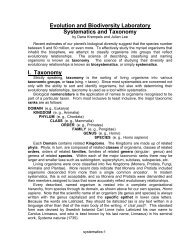Pollination Biology and the Impact of Floral Offer, Pollen Donor ...
Pollination Biology and the Impact of Floral Offer, Pollen Donor ...
Pollination Biology and the Impact of Floral Offer, Pollen Donor ...
Create successful ePaper yourself
Turn your PDF publications into a flip-book with our unique Google optimized e-Paper software.
To determine if <strong>the</strong>re is a difference in <strong>the</strong> numbers <strong>of</strong> ovules produced by pin <strong>and</strong><br />
thrum flowers, we collected from different patches ano<strong>the</strong>r 40 flowers <strong>of</strong> each floral<br />
morph. Carpels were dissected, recording <strong>the</strong> number <strong>of</strong> ovules per flower. Similarly, to<br />
determine differences in <strong>the</strong> number <strong>of</strong> pollen grains produced by pin <strong>and</strong> thrum flowers<br />
we additionally collected 15 recently-opened flowers <strong>of</strong> each floral morph. For each<br />
flower, one <strong>of</strong> <strong>the</strong> four an<strong>the</strong>rs was selected, opened on a microscope slide, <strong>and</strong> all pollen<br />
grains were counted. To estimate <strong>the</strong> total number <strong>of</strong> pollen grains per flower, <strong>the</strong> number<br />
<strong>of</strong> grains counted was multiplied by <strong>the</strong> number <strong>of</strong> an<strong>the</strong>rs per flower.<br />
To examine differences in pollen size between floral morphs, we dissected<br />
indehisced an<strong>the</strong>rs from 18 pin <strong>and</strong> 20 thrum flowers collected from different patches.<br />
Pictures <strong>of</strong> <strong>the</strong> pollen grains were obtained using a digital camera attached to a light<br />
microscope at 160 X magnification. Using <strong>the</strong> digital images, we measured <strong>the</strong> diameters<br />
<strong>of</strong> at least 114 pollen grains per flower with <strong>the</strong> application Sigmascan Image ® (Link et<br />
al. 1994) (Min – Max. number <strong>of</strong> pollen grains measured per flower = 114 – 444, N pin<br />
grains = 3840, N thrum grains = 4548). We tested for differences in each morphological<br />
attribute between floral morphs by using t tests..<br />
FLORAL BIOLOGY AND BREEDING SYSTEM.–––To test for differences in nectar production<br />
among morphs, we measured <strong>the</strong> volume <strong>of</strong> nectar produced per flower in 5 to 11 flowers<br />
per patch in 10 pin <strong>and</strong> 12 thrum patches (N pin flowers = 64, N thrum flowers = 87). Nectar was<br />
collected 24 h. after an<strong>the</strong>sis from previously bagged flowers, using 1 μl micro–pipettes.<br />
Volume was calculated using calipers precise to <strong>the</strong> nearest 0.01 mm. Differences<br />
-5-

















